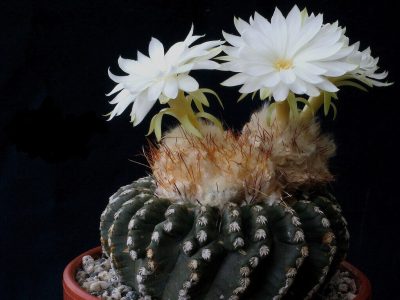Plant watering with ammonium sulfate and acidified water
By Don I. Campbell
January 2013

In 2010 the CSSA Cactus & Succulent Journal had two articles addressing the use of ammonium nitrogen and acidic water for xerophytic plant growth. Based on these articles, the following is a brief description of the process I’ve adopted to acidify my tap water and incorporate ammonium sulfate into my regular watering regimen.
Water provided by the Ute Water Conservancy District in the Redlands comes out of the tap with a pH of about 8.0. I’ve found that adding 2 teaspoons of distilled white vinegar (5% acidity) to one gallon of tap water will lower the pH to the recommended level of about 5.0 to 5.5. (Water from other providers may have a different pH). I use a wide spectrum pH test indicator kit (range from 4.0 to 8.5) purchased from Desert Bloom Hydroponics, 445 Pitkin Ave. in Grand Junction. As indicated in the articles by Keith and in the CSSA Journal, one should periodically check the pH of their water.
Following some testing, calculating and a bit of ‘guessing’, I’ve adopted the following plant watering formulation. Add 2 teaspoons of distilled white vinegar (5% acidity), 1 teaspoon of a granular ammonium sulfate (21-0-0 guaranteed analysis), 1/4 teaspoon of a granular water soluble fertilizer (20-20-20 guaranteed analysis), and enough tap water to fill a one gallon plastic container. Mix thoroughly and slowly apply the mixture to the soil at the top of the pot. Allow a small amount of the solution to drain out the bottom of the pot but do not allow the pots to stand in any of the surplus water.
Recently, on my watering day, I began mixing a concentrate of the vinegar, ammonium sulfate and fertilizer to speed up the mixing and watering process. I begin with a 1 quart (32 oz) plastic bottle with a screw top lid and add:
- 4 teaspoons of a granular ammonium sulfate (21-0-0 guaranteed analysis).
- 1 teaspoon of a granular water soluble fertilizer (20-20-20 guaranteed analysis)
- 8 teaspoons of distilled white vinegar (5% acidity)
Fill the quart bottle about 3/4 full with hot water, cap and shake vigorously until the ammonium sulfate and fertilizer granules are completely dissolved. Top off the quart bottle with enough cool water to make an even quart (32 ounces). One can easily expand the quantities shown above to mix larger quantities of the concentrate.
I add 1 cup (8 ounces) of this concentrate along with with enough tepid tap water to fill my 1 gallon plastic watering can. Be aware that if acetic acid (vinegar) is mixed with water and allowed to sit for some time, the pH level may climb. Therefore, the concentrate should be used reasonably soon after mixing. Plastic containers are recommended when mixing and applying the low pH and ammonium sulfate water.
During periods of plant dormancy, you should probably use only the acidified water, eliminating the fertilizer and ammonium sulfate from your water mixture. Twice a year (about March & September) I add one ounce of Bayer Advanced 12 Month Tree & Shrub Formula to each gallon of my acidified plant watering mixture. The active ingredient in the Bayer Advanced formula is 1.47% Imidacloprid, a systemic insecticide. Be aware that my rate of application of the Bayer Advanced Tree & Shrub formula is greater than what is recommended on the label. The Bayer Advanced also contains a guaranteed 2-1-1 fertilizer. There is also a Bayer Advanced 3-in-1 Insect, Disease & Mite Control formulation that contains only 0.47% of the Imidacloprid. If you use the 3-in-1 formula you will need to add about 3 ounces per gallon to get the same level of the active systemic Imidacloprid.
